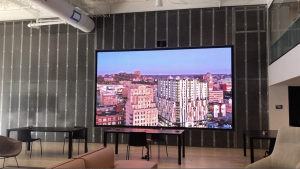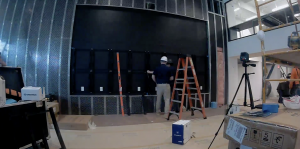A Video Wall to Showcase the Design Work of GBBN Architects

Trinity Dynamics works with a variety of customers across a broad range of businesses and industries. Each have varied, and important, uses for the audiovisual technology we provide for them. A recently completed project was at the corporate office of GBBN Architects in Cincinnati, Ohio. The firm was in the process of redoing their main lobby area and wanted a show-stopper of a video wall that would allow them to showcase their portfolio of work in an immersive, interactive way through the use of video. Their goal with this installation was to use audiovisual displays to showcase their impressive design work in the most dynamic way possible.
The team at GBBN realized that using audiovisual technology to provide an interactive look at their architectural design projects is one of the best ways to engage their clients and display their portfolio of work — and to provide inspiration for future projects — so they turned to the team at Trinity Dynamics.
Audiovisual Design that is interactive, immersive, informative
GBBN is an award-winning, international architecture firm known for modern design and out-of-the-box take on building design, so any sort of audiovisual display needs to be exceptional in order to complement the design level of their projects — GBBN uses the power of interactive video to allow viewers to visually tour each project. This helps viewers grasp the magnitude of GBBN’s designs, with projects that include the Andrew J Brady Icon Music Center (the Icon) on Cincinnati’s riverfront, the transformation of Zoo Tower, a landmark in Beijing’s Xicheng district, and the addition of the Mascaro Center at the University of Pittsburgh, and many other impressive projects spanning the globe.
“It never ceases to amaze me how folks with an architectural mind, like the folks at GBBN, can see a blank or existing space and then mentally visualize the final outcome,” says Tim Barrett, Project Manager at Trinity Dynamics, who oversaw this project.
On their website, GBBN explains how the firm combines “creative tenacity, technical mastery, and a global perspective to deliver design solutions.” The team at GBBN says they see architecture as more than just buildings, because they believe that positively affecting people is the most important thing they do.
So, a large-scale video wall installation was the way to go — the Trinity Dynamics team of engineers got to work developing plans for the 16-foot by 9-foot wall in the firm’s soaring, two-story lobby.
“We love being part of construction projects from demolition to completion,” says Barrett. “Seeing the raw skeleton of a building and then being part of the team that helps turn it into a finished product is always a very rewarding feeling and sense of accomplishment for each individual and company.
And, Barrett says, an unexpected part of the installation was seeing people from other trades stop and watch as we installed the 16’ x 9’ seamless video wall. “It gave our team a little boost of pride knowing that once completed, it will be the center of attention and showpiece of the entire project.”

The Technical Specs
The video wall installed at GBBN is the Acclaim 1.9 Plus by Absen. It has a 1.91mm Pixel Pitch and consists of (64) “Cabinets,” each containing four Direct View LED Panels. The seamless 220-inch diagonal wall is 16-feet wide and 9-feet high. The processing is handled by two NovaStar VX4S dvLED video wall Controllers. The video wall is recessed with only three inches of clearance on all sides for ventilation.
Time lapse video of the Trinity Dynamics installation at GBBN Architects
For a fun look at this project, check out the time-lapse video of the installation here. Here are some highlights:
- Prepping the wall and measuring to obtain accurate center line and other needed points of reference to ensure all mounting hardware will line up and fit properly into the designated space.
- Begin installation of mounting hardware. Level throughout the installation process to the LED panels for the video wall will be lined up and flush together.
- Placing shims (spacers) between the mounting hardware and the wall to ensure the video wall is perfectly flush and flat prior to installing the LED panels.
- Installation of Video Wall Cabinets (basically the LED housing the LED panel will latch onto). Installation cabling throughout to connect the panels together.
- Ensuring power and data connectivity between each row of cabinets and modules.
- Install LED panels and test video signals as we go along.
- Replacing any panels that had any defects (bad LED pixels) with spares that are provided.
- Final touch ups — and done!

